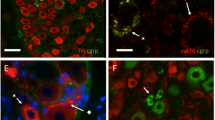Abstract.
Estrogen receptor-α immunoreactivity and mRNAs are present in neurons in locales that innervate genital organs, e.g., parasympathetic pelvic autonomic ganglia, sensory dorsal root and nodose ganglia, and autonomic areas of the lumbosacral spinal cord. With the availability of probes for the β-isoform of the estrogen receptor, we studied this receptor in autonomic, sensory, and spinal cord neurons and compared it with the distribution of the α-receptor. Estrogen receptor-α and -β immunoreactivity were located in the nuclei of neurons, were in subpopulations of parasympathetic neurons in pelvic ganglia, and sensory neurons of dorsal root and nodose ganglia. Both receptor subtypes were present in the lumbosacral spinal cord: in neurons of the outer laminae of the dorsal horn, lateral collateral and medial collateral pathways, sacral parasympathetic nucleus, dorsal intermediate gray, and lamina X. Similar numbers of spinal cord neurons were immunoreactive for estrogen receptor-β and estrogen receptor-α. However, estrogen receptor-β-immunoreactive neurons appeared less numerous in the outer dorsal horn, but more numerous in the deeper layers of the spinal cord than estrogen receptor-α neurons. Retrograde tracing from the uterus revealed "uterine-related" neurons in dorsal root and pelvic ganglia that contained estrogen receptor-α and -β. In situ hybridization revealed both estrogen receptor-α and -β mRNA transcripts in sensory neurons of the dorsal root and nodose ganglia, parasympathetic neurons of pelvic ganglia, and spinal cord neurons in the dorsal horn, sacral parasympathetic nucleus, and dorsal intermediate gray of L6-S1 segments. These studies show that both estrogen receptor-α and -β are synthesized by autonomic and sensory neurons in parts of the nervous system that have connections with the female reproductive system. Such neurons contain neurotransmitters that have important functions in the female reproductive organs; thus, it is likely that estrogen can influence the activity of such neurons and consequently, through them, the activities of the reproductive organs.
Similar content being viewed by others
Author information
Authors and Affiliations
Additional information
Electronic Publication
Rights and permissions
About this article
Cite this article
Papka, R., Storey-Workley, M., Shughrue, P. et al. Estrogen receptor-α and -β immunoreactivity and mRNA in neurons of sensory and autonomic ganglia and spinal cord. Cell Tissue Res 304, 193–214 (2001). https://doi.org/10.1007/s004410100363
Received:
Accepted:
Issue Date:
DOI: https://doi.org/10.1007/s004410100363




